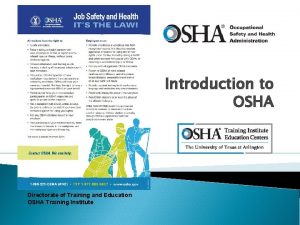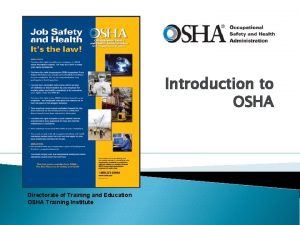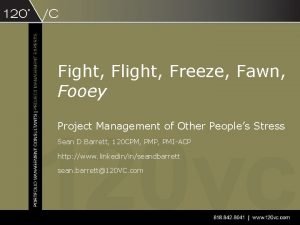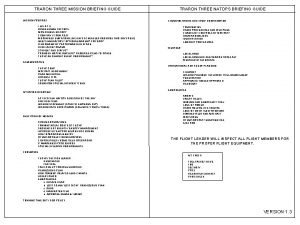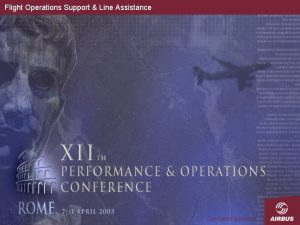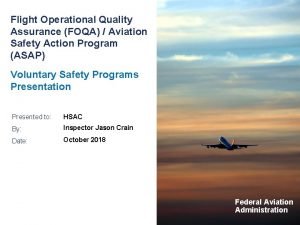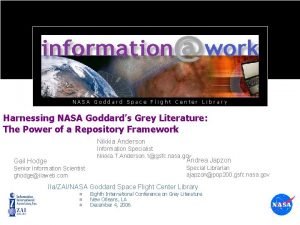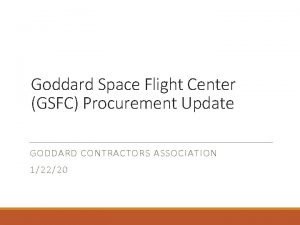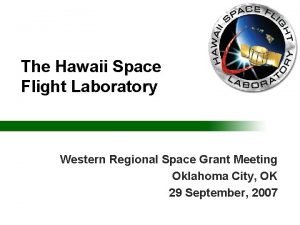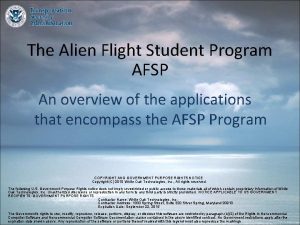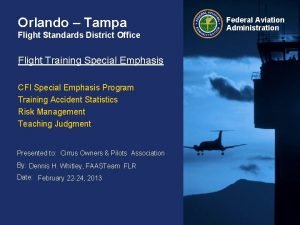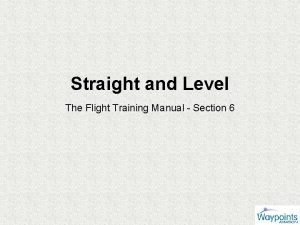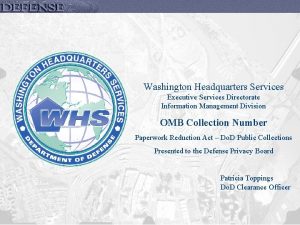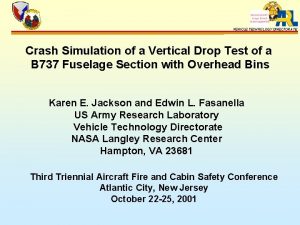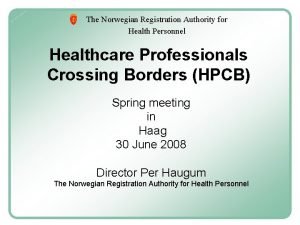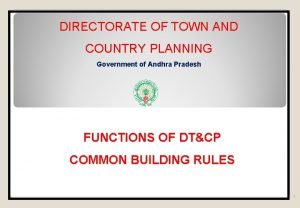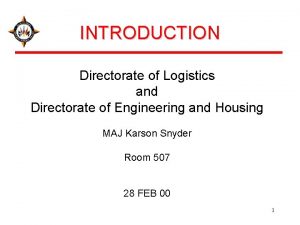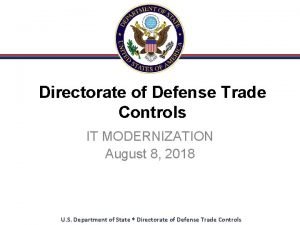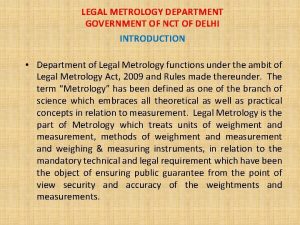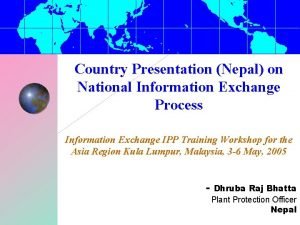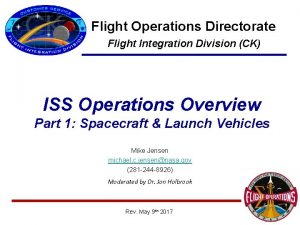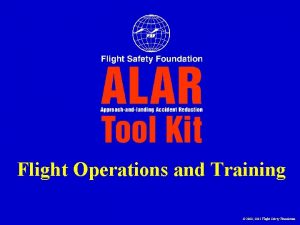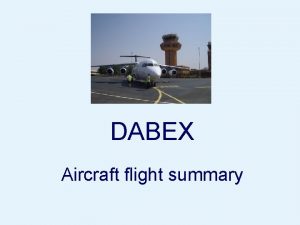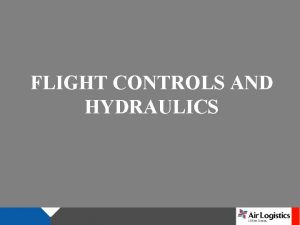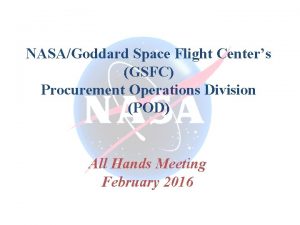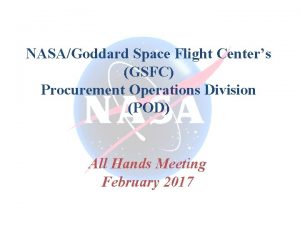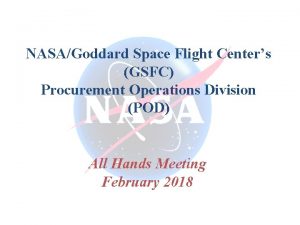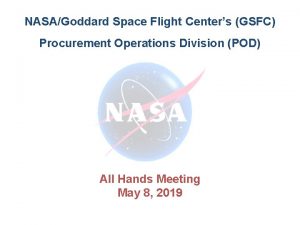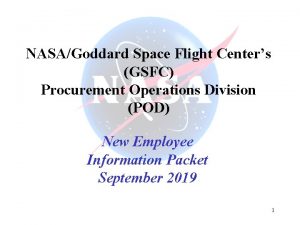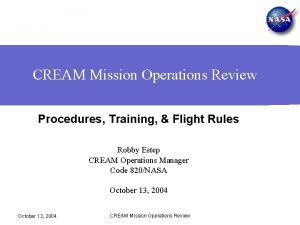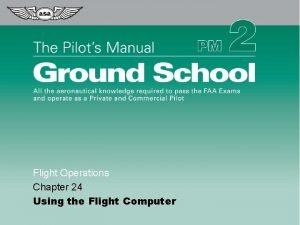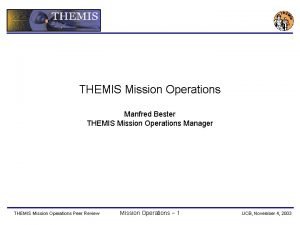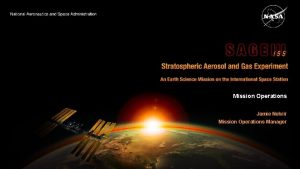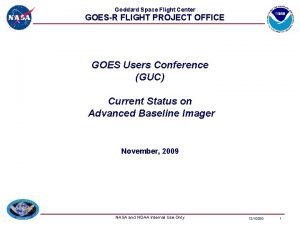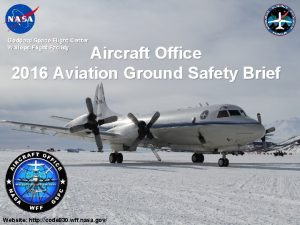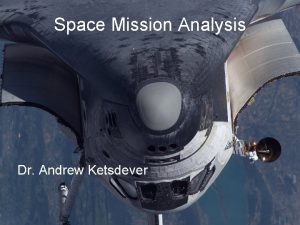MISSION OPERATIONS DIRECTORATE SPACE FLIGHT TRAINING DIVISION 2




































- Slides: 36

MISSION OPERATIONS DIRECTORATE SPACE FLIGHT TRAINING DIVISION 2. 6 Basic Orbit Mechanics September 24, 2004 Copyright © 2004 by United Space Alliance, LLC. These materials are sponsored by the National Aeronautics and Space Administration under Contract NAS 9 -20000. The U. S. Government retains a paid-up, nonexclusive, irrevocable worldwide license in such materials to reproduce, prepare derivative works, distribute copies to the public, and perform publicly and display publicly, by or on behalf of the U. S. Government. All other rights are reserved by the copyright owner. USA 007687 Rev A

Basic Orbital Mechanics: Lesson Objectives þ þ þ USA 007687 Rev A As a result of the basic orbital mechanics presentation, the phase I student will be able to do the following: Describe the characteristics of an orbit using the cannonball analogy State that the shuttle flies in elliptical orbits Identify parabolic & hyperbolic orbits as escape trajectories Match the definition statement for each of the following terms: · · Perigee Eccentricity Inclination Orbital Period · Apogee · Ascending Node · Line of Apsides · Flight Path Angle · Semimajor Axis · Descending Node · Beta Angle · Nodal Regression

Basic Orbital Mechanics: Lesson Objectives þ þ þ USA 007687 Rev A Describe the relationship between an orbital period and orbital altitude Describe the relationship between orbital altitude and orbital velocity Describe orbital velocity behavior as an orbiting object approaches apogee & perigee Identify the characteristics of posigrade, retrograde, radial in, and radial out burns Describe a Hohmann transfer Describe the primary constraint on changing orbital plane

Basic Orbital Mechanics: Lesson Objectives þ þ þ Recognize the restrictions that launch site latitude places on achievable orbital inclination Describe the basic components of a launch window graph Identify the rationale behind launching east from KSC State the rationale for the restriction on launch azimuth Describe why the groundtrack of the shuttle traces a sinusoid across a flat map of the Earth Describe the cause & effect of two possible orbit perturbations (atmospheric drag & nonsphericity of the Earth) USA 007687 Rev A

What is an Orbit? USA 007687 Rev A The key concept of the CANNONBALL ANALOGY: The ______ of the falling ball’s _____ matches the _______ of the Earth’s ________. PROPERTIES of an ORBIT: ______ is INERTIALLY STABLE Motion is ________ Freefall = “ZERO-G”

The Three Basic Types of Conic Orbits “In orbit” ¥ “Minimum Escape Trajectory” “Escape or fly-by” USA 007687 Rev A

Orbital Elements: Size, Shape, Orientation, & Location Semi-major Axis a Line of Apsides e = 0. 88 e = 0. 99 USA 007687 Rev A The semi-major axis determines the ______ of an orbit ____ is the closest point of approach to Earth ____ is the farthest point on the orbit from Earth Eccentricity determines the ____ of an orbit Time since Perigee passage can provide the ____ of the spacecraft in a given orbit

USA 007687 Rev A Orbital Elements: Continued X & Y lie in the _____ Z is the _______ Z M 50 Inertial Reference Frame Y X Z Plane of Equator i Inclination is the angle between the _________ and the orbit ____. X Inclination Y

Orbital Elements: Continued Z USA 007687 Rev A The Right Ascension of the Ascending Node (W) is the angle between the M 50 _______ and the orbit’s _________ Y X W Z Line of Nodes The Argument of Perigee (w) is the angle between the ______ node and the X _____ of the orbit Perigee w Y Ascending Node

Orbital Elements: Concluded Z Perigee tp w a Plane of Equator X i USA 007687 Rev A The six orbital elements define the _____, ______, and ______ of the orbit and the _____ of the spacecraft on the orbit Y W e Ascending Node RECORD SHUTTLE VALUES: a = 3781 nm (h = 337 nm) (STS-82) e = 0. 03 (313 x 95 nm, STS-109) 28. 35° < i < 62° (STS-49) (STS-36)

USA 007687 Rev A Orbital Period vs. Orbital Altitude a 3 T = 2 p m m = Gravitational Parameter h = 160 n. mi T = 90 minutes “High” Earth Orbit H = 3444 n. mi T = 4 hours As orbital altitude increases, orbital period ______. Geosynchronous Orbit h = 19, 324 n. mi T = 23 h 56 m 4 s

USA 007687 Rev A Orbital Velocity vs. Orbital Altitude Circular Orbits V = m a h = 160 n. mi V = 25, 300 ft/s “High” Earth Orbit H = 3444 n. mi V = 18, 341 ft/s As orbital altitude increases, orbital velocity _____. Geosynchronous Orbit h = 19, 324 n. mi V = 10, 087 ft/s

USA 007687 Rev A Orbital Velocity vs. Orbital Altitude (Elliptical Orbits) V= m ( r 2 1 a ) r = Radial Vector from Center of Earth h = 19, 324 n. mi V = 5, 273 ft/s h = 160 n. mi V = 33, 320 ft/s Geosynchronous Transfer Orbit a = 13, 186 n. mi e = 0. 726 On an elliptical orbit, velocity is greatest at ____ and least at ____.

Flight Path Angle USA 007687 Rev A ori H cal Lo Orbital Direction zon tal -g Velocity Vector al V H Ve rtic cal al Lo Lo ori zon tal L l oca ic ert +g Velocity Vector Flight Path Angle is the angle between an orbiting spacecraft’s ____ vector & the local _____.

USA 007687 Rev A Changing Orbits - The Effects of Burns Posigrade & Retrograde Orbital Direction æ 2 1ö V = mç - ÷ è r aø Dh DV DV Dh A _____ burn will RAISE orbital altitude (max. at 180° from the burn point); a ______ burn will lower orbital altitude (max. at 180° from the burn point).

USA 007687 Rev A Changing Orbits - The Effect of Burns Radial In & Radial Out EXAMPLE: Radial In Burn at Perigee rn u B n l I a adi R Resultant Velocity Initial Velocity Radial burns shift the ________ without significantly altering other orbital parameters V= m ( r 2 1 a )

USA 007687 Rev A Orbital Transfers - The Hohmann Orbital Direction Burn 2 Orbit 1 • Circular to circular • Coplanar • Two burns • Least expensive energy wise Burn 1 Orbit 2 Lowering orbits via two retrograde burns can also be accomplished.

USA 007687 Rev A Orbital Transfers - Changing Planes V 2 DV V 1 • Burn point must be intersection of two orbits (“nodal crossings”) • Extremely expensive energywise: For 160 nmi circular orbits, a 1° of plane change requires a DV of over 470 ft/sec.

USA 007687 Rev A Orbital Transfers - Going Uphill and Changing Planes Example: Transfer of Comsat to Geosynchronous orbit. Dihigh Orbit 1 i = 28. 5 Transfer Orbit Dilow Orbit 2 i = 0. 0 Line of Nodes Given h 1 = 160 nmi & h 2 = 19, 300 nmi: MINIMUM TOTAL DV achieved with Dilow = 2. 2° Di high = 26. 3°

USA 007687 Rev A Orbital Transfers - Lambert Targeting 2 1 R 2 R 1 2 DT Permits 3 -dimensional transfers between two arbitrary orbits in a fixed time. Given : the start position (R 1), the final position (R 2), and the time of transfer (DT) 1 2 Lamberts Theorem computes the ______ ORBIT from R 1 to R 2. Used in Rendezvous. 1

USA 007687 Rev A Ground Matters - Launch Site Latitude & Inclination Orbital Plane (Higher Inclination) Orbital Plane (Minimum Inclination) Launch Site Latitude Equator Time to Launch! Minimum Inclination Desired Orbit Minimum achievable INCLINATION = Launch Site _____

Launch Windows Driven By: Lighting (Launch/ Abort / Landing Satellite Deploy/Retrieve) Rendezvous (Lighting, Planar Geometry, Phasing) Planetary Geometry (For Deep Space Missions) Ground Target Conditions (Lighting, Overflight Timing) Crew Fatigue Limitations USA 007687 Rev A

Launch Windows Driven By: Lighting (Launch/ Abort / Landing Satellite Deploy/Retrieve) Rendezvous (Lighting, Planar Geometry, Phasing) Planetary Geometry (For Deep Space Missions) Ground Target Conditions (Lighting, Overflight Timing) Crew Fatigue Limitations USA 007687 Rev A

USA 007687 Rev A Ground Matters - Launch Azimuth True North = 0° Measured +clockwise Due East = ____ Due South = ____

USA 007687 Rev A Ground Matters - Launch Azimuth Determination Azimuth 1 From KSC (Latitude = 28. 5°) N Orbit 1 (i = 57°) Azimuth = 38. 3° (or 141. 7°) Azimuth 2 Orbit 2 (i = 35°) Azimuth = 68. 8° (or 111. 2°) Orbit 2

USA 007687 Rev A Ground Matters - Launch Azimuth Restrictions Launch Azimuth is restricted due to _______ concerns. East Coast Limit: _____ (i = 57°) Operational Southern Limit: 90° (i = _____) Caribbean Islands Limit: _____ (i = 39°)

USA 007687 Rev A Ground Matters - The Rotating Earth VLaunch Site KSC’s easterly velocity is ~ 1000 mph (1347 ft/sec, or 5. 3% of orbital velocity) VLaunch Site Launching directly east yields the maximum payload-to-orbit capability. R Launch Site VOrbital

Ground Track USA 007687 Rev A Nodal Shift Maximum Latitude Ground track shifts about 22° west on each orbit as the Earth rotates beneath. Maximum latitude = Inclination Nodal Shift = function of orbit size (a) North/South Symmetry = function of eccentricity & perigee location

USA 007687 Rev A Orbit Perturbations - Atmospheric Drag BOOM! Atmospheric density is a function of latitude, solar heating, season, land masses, etc. Drag also depends on spacecraft attitude Lower apogee of elliptical orbit Perigee remains relatively constant, like a retrograde burn each orbit Once Ha = Hp, relatively constant drag causes steady altitude loss

USA 007687 Rev A Orbit Perturbations - Gravitational Potential n n ¥ ¥ ü é ae ù U = í 1 J n ê ú Pn (sin( f )) + P nm (sin( f )) Cnm cos( ml ) + S nm sin( m l ) ý å å êë r úû r î å ërû n= 2 þ n = 2 m= 1 mì ¥ Spherical Term Zonal Harmonics [ ] where m = Universal Gravitational Constant X Mass of Earth r = Spacecraft Radius Vector from Center of Earth ae = Earth Equatorial Radius P() = Legendre Polynomial Functions f = Spacecraft Latitude l = Spacecraft Longitude Jn = Zonal Harmonic Constants Cn, m, Sn, m = Tesseral & Sectorial Harmonic Coefficients Only the first 4 X 4 (n=4, m=4) elements are used in shuttle GNC software. J 2 has 1/1000 th the effect of the spherical term; Tesseral Harmonics Sectorial Harmonics all other terms start at 1/1000 th of J 2’s effect. Just know that the higher order terms are present and the software accounts for them.

USA 007687 Rev A Orbit Perturbations - “The J 2 Effect” h orbit h J 2 The Earth’s oblateness causes the most significant perturbation of any of the nonspherical terms. Right Ascension of the Ascending Node, Argument of Perigee and Time since Perigee Passage are affected. 100 200 300 Nodal Regression is the most important operationally. Magnitude depends on orbit size (a), shape (e) and inclination (i). -6. 7 500 Typical Shuttle Orbits 1000 Posigrade orbits’ nodes regress Westward (0° < i < 90°) Retrograde orbits’ nodes regress Eastward (90° < i <180°) 10 20 30 0 3940 50 60 70 80 170 160 150 140 130 120 110 100 Inclination, Degrees 90

USA 007687 Rev A i rb f O Solar Beta Angle a Pl Sun The angle between the Orbit’s and the Line of Sight to the o e n b (POSITIVE is TOWARDS the Angular Momentum Vector) (The Russian Program uses a angle, where a = -b) Primary concerns with b angle are THERMAL ENVIRONMENT and Solar Cell Power Generation Capability Combinations of b angle and inclination result in some interesting situations Northern Hemisphere Over Flight Is Always In Darkness Constant Daylight t

USA 007687 Rev A ORBITAL MECHANICS QUESTIONS 1. What is the “KEY PHRASE” of the cannonball analogy? ______________________________________ 2. What kind of orbit does the shuttle fly in? ____________ 3. What is the closest point of approach on an orbit? ______ The furthest point? ______ 4. The size of an orbit is defined by _________________ 5. The shape of an orbit is defined by ________________ 6. The angle between the plane of the equator and the plane of the orbit is ___________ 7. When the shuttle crosses the equator, it is passing through a ___________ 8. As orbital altitude increases, orbital period ____________ 9. As orbital altitude increases, orbital velocity _____________ 10. In an elliptical orbit, velocity is greatest at_______and least at _________ 11. A posigrade/retrograge burn ___________ your velocity and ___________ your altitude on the other side of the earth. 12. The cheapest orbital transfer is the__________transfer.

USA 007687 Rev A ORBITAL MECHANICS QUESTIONS 13. Orbital inclination cannot be lower than launch site _________ 14. Name three possible constraints to time of launch: __________________________________________________ 15. Launch azimuth is restricted due to __________concerns. 16. Launching east increases ______________ performance because of ___________. 17. The groundtrack of the shuttle is shaped like a _______________ 18. On a groundtrack, maximum latitude equals _____________ 19. The groundtrack of a shuttle shifts westward on each revolution because the ________________ 20. Orbital decay is caused by _____________. 21. The angle between the orbit’s plane and the Line of Sight to the Sun is defined as ______.

USA 007687 Rev A ORBITAL MECHANICS ANSWERS 1. 2. 3. 4. 5. 6. 7. 8. 9. 10. 11. 12. 13. 14. 15. 16. 17. 18. 19. 20. 21. The curve of the falling ball’s trajectory matches the curve of the Earth’s surface. Elliptical Perigee, Apogee the semi-major axis (a). the eccentricity (e). the inclination (i). node. increases. decreases. perigee , apogee. increases/decreases , increases/decreases Hohmann latitude. lighting, rendezvous (lighting, plane geometry, phasing, etc), planetary geometry, ground target conditions, crew fatigue limitations, etc. safety payload carrying , Earth’s rotation. sinusoid. inclination. Earth rotates beneath the orbit. atmospheric drag. Beta angle.

USA 007687 Rev A Change History Rev. Letter Description Date Basic Baseline issue 05/31/2003 CPN-1 Inserted copyright statement to cover slide 06/22/2004 Updated names, trajectory records, various cosmetic fixes 9/24/2004 A
 Norwegian directorate for education and training
Norwegian directorate for education and training Osha directorate of training and education
Osha directorate of training and education Osha directorate of training and education
Osha directorate of training and education Osha directorate of training and education
Osha directorate of training and education Fight flight freeze fawn quiz
Fight flight freeze fawn quiz Prebrief
Prebrief Flight operations support
Flight operations support What is aviation safety action program
What is aviation safety action program Goddard space flight center library
Goddard space flight center library Gsfc contractors
Gsfc contractors Albedo
Albedo Hawaii space flight laboratory
Hawaii space flight laboratory Alien student flight program
Alien student flight program Tampa fsdo office
Tampa fsdo office How to maintain straight and level flight
How to maintain straight and level flight Indicated altitude
Indicated altitude Flight school management platform
Flight school management platform Alpine flight training
Alpine flight training Executive services directorate
Executive services directorate Veterinary medicines directorate
Veterinary medicines directorate Vehicle technology directorate
Vehicle technology directorate Norwegian registration authority for health personnel
Norwegian registration authority for health personnel Early childhood education and care directorate
Early childhood education and care directorate Technical education karnataka
Technical education karnataka Fort drum dpw
Fort drum dpw Dtcp ap
Dtcp ap European directorate for the quality of medicines
European directorate for the quality of medicines Public affairs directorate oxford
Public affairs directorate oxford Directorate for logistics functions
Directorate for logistics functions Hsarpa
Hsarpa Deccs registration renewal
Deccs registration renewal Directorate general for competition
Directorate general for competition Marketed health products directorate
Marketed health products directorate Office of the controller legal metrology
Office of the controller legal metrology Directorate curriculum fet
Directorate curriculum fet Plant protection directorate nepal
Plant protection directorate nepal Agriculture fisheries and food authority
Agriculture fisheries and food authority


